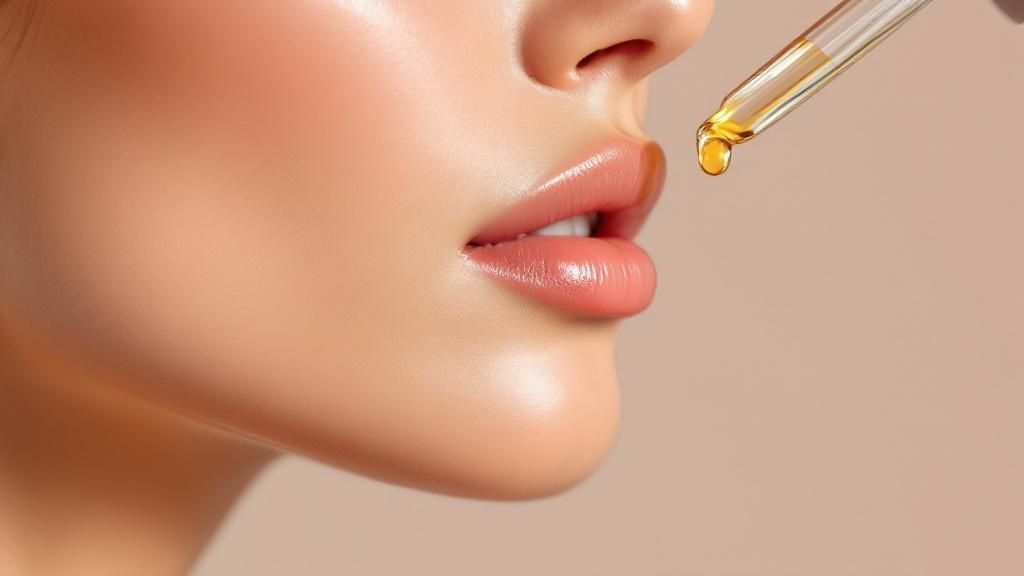
If you've just started using a retinol serum, you might be looking in the mirror wondering what’s going on. The sudden dryness, flaking, and maybe even a little redness can feel alarming, but take a breath. It's usually a completely normal—and temporary—part of the process.
This initial adjustment is so common it has its own name: retinization. Think of it as your skin’s orientation week for retinol. It’s a sign that the product is actually getting to work.
Why Your Skin Is Reacting to Retinol
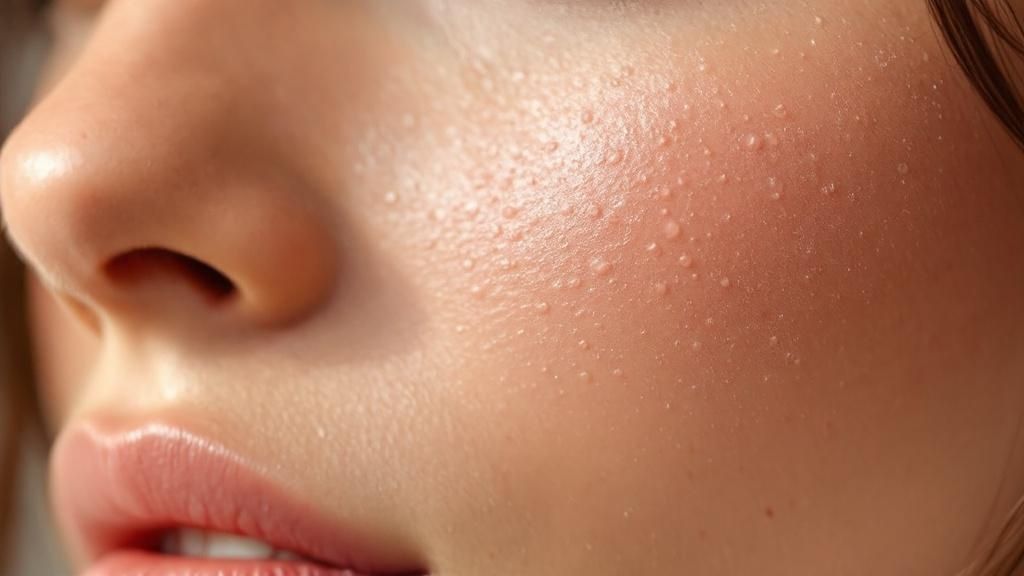
Starting retinol is like sending your skin to bootcamp. It’s an incredibly effective ingredient because it dramatically speeds up your skin's cell turnover rate.
Basically, retinol is waking up your sluggish skin cells, telling them to shed the old, dull, damaged layers much faster than they normally would. This rapid renewal is what brings fresh, healthy skin to the surface—but it's also what causes those temporary growing pains.
The Retinization Phase Explained
"Retinization" is the official term for the two- to four-week period where your skin is building up tolerance to vitamin A. It’s learning to handle this powerful new active.
During this time, it's very common to experience:
- Dryness and Tightness: As cell turnover kicks into high gear, your skin's protective barrier can get a little overwhelmed, leading to temporary water loss.
- Peeling or Flaking: This is the most obvious sign that things are working. You're literally seeing old skin cells making way for the new.
- Mild Redness: All that increased cellular activity can cause a temporary flush.
While these reactions are expected, it's important to know the difference between a normal adjustment and a sign of true irritation. Retinol is FDA-approved for topical use, but you need to listen to your skin.
While common reactions like peeling are most intense in the first few weeks, statistics show that fewer than 10% of users experience more severe side effects like blistering or significant swelling.
Navigating the initial weeks of retinol is all about patience. The key is to support your skin with gentle cleansers and rich, soothing moisturizers. Let it adapt at its own pace without pushing it too hard.
Normal vs Concerning Side Effects in Early Retinol Use
It can be tough to tell what's "good" irritation versus "bad" irritation. Here’s a quick guide to help you figure out what your skin is telling you.
| Side Effect | What's Usually Normal (First 2-4 Weeks) | When to Be Concerned |
|---|---|---|
| Redness | A mild, pinkish flush, similar to a light sunburn. | Bright red, hot-to-the-touch skin; persistent inflammation. |
| Peeling | Light, flaky peeling, especially around the nose and mouth. | Large sheets of peeling skin or raw, cracked areas. |
| Dryness | A feeling of tightness and visible dryness that moisturizer helps. | Severe, painful cracking that doesn't improve with moisturizer. |
| Breakouts | A temporary increase in small pimples ("purging"). | Deep, painful cystic acne or a rash-like breakout. |
| Sensation | Mild tingling or a slight warm feeling right after application. | A burning, stinging sensation that lasts or is very intense. |
If your symptoms fall into the "When to Be Concerned" column, it's a good idea to take a break from retinol for a few days and let your skin recover. When you reintroduce it, use less product and apply it less frequently.
For those with very reactive skin, understanding how to manage that sensitivity from the start is crucial. We have a guide dedicated to achieving a radiant complexion with a gentle routine that can help.
A great way to ease into it is by choosing a well-formulated product designed for beginners. The BARB N.P. Retinol & Bakuchiol Serum, for instance, pairs retinol with soothing ingredients to make the retinization process much smoother. By starting low and slow, you can move through this phase with confidence and get to the glow on the other side.
The Science Behind Retinol Irritation
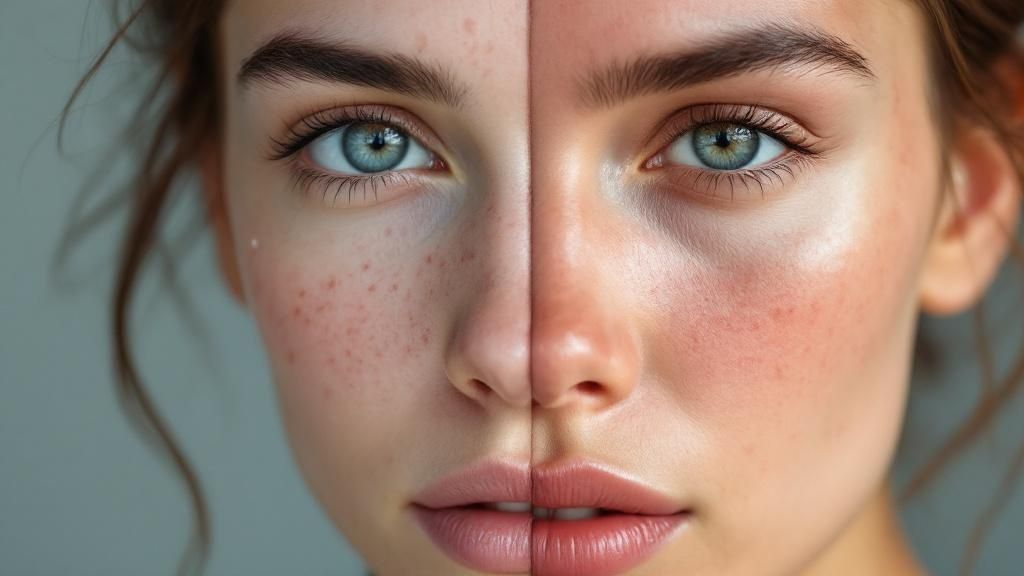
To understand why retinol side effects pop up, you have to look at what’s happening on a cellular level. Retinol isn’t just a surface-level treatment; it sinks deep into your skin and essentially tells your cells to start acting young again.
Its main job is to dramatically speed up skin cell turnover. Think of your skin cells as being on a slow conveyor belt, moving from the bottom layers up to the surface where they eventually flake off. Retinol hits the fast-forward button on that entire process.
This rapid renewal is amazing for long-term goals like softening fine lines and fading sun spots. In the short term, though, this cellular rush hour is what causes all that visible peeling and flaking. Your skin is literally shedding its old, tired top layer to reveal fresh, new skin underneath.
How Cell Turnover Affects Your Skin Barrier
As this turbocharged turnover kicks in, it can temporarily throw your skin’s protective moisture barrier out of whack. The easiest way to picture your skin barrier is like a brick wall: the skin cells are the bricks, and natural lipids (fats) are the mortar holding it all together.
Retinol’s intense activity can create tiny, temporary gaps in that mortar. This leads to something called transepidermal water loss (TEWL), where moisture starts escaping from your skin way too easily. The result? That classic tightness and dryness many first-time retinol users know all too well.
This is the key takeaway: The irritation isn't a sign that retinol is harming your skin. It’s proof that this powerhouse ingredient is actively remodeling it from the inside out. The goal isn’t to stop the process, but to support your skin as it adjusts.
This adjustment period, often called retinization, is when your skin learns to handle the increased activity and rebuilds its barrier to be stronger and more resilient. While everyone is different, it generally takes three to six months of consistent use to see major improvements in texture, with the most dramatic results often appearing after a year.
Managing the Biological Response
Once you understand the science, you can shift from just reacting to irritation to proactively supporting your skin. You can manage these common retinol serum side effects by doubling down on barrier repair.
Here’s what your skin is craving during this phase:
- Hydration: Ingredients like hyaluronic acid and glycerin are like a big drink of water for your skin, helping to counteract that moisture loss.
- Nourishment: Ceramides and fatty acids act like fresh mortar for your skin barrier, filling in those gaps to restore strength and balance.
- Protection: Daily sunscreen is an absolute must. With its top layer shedding, your brand-new skin is far more vulnerable to sun damage.
Choosing a well-formulated product can make all the difference. The BARB N.P. Retinol & Bakuchiol Serum, for example, was designed to balance potent results with skin comfort. By pairing retinol with soothing bakuchiol, it helps calm irritation while still delivering powerful anti-aging benefits, making that adjustment period feel much smoother. Working with your skin’s biology is the smartest way to get that coveted retinol glow.
How Retinol Strength Influences Side Effects
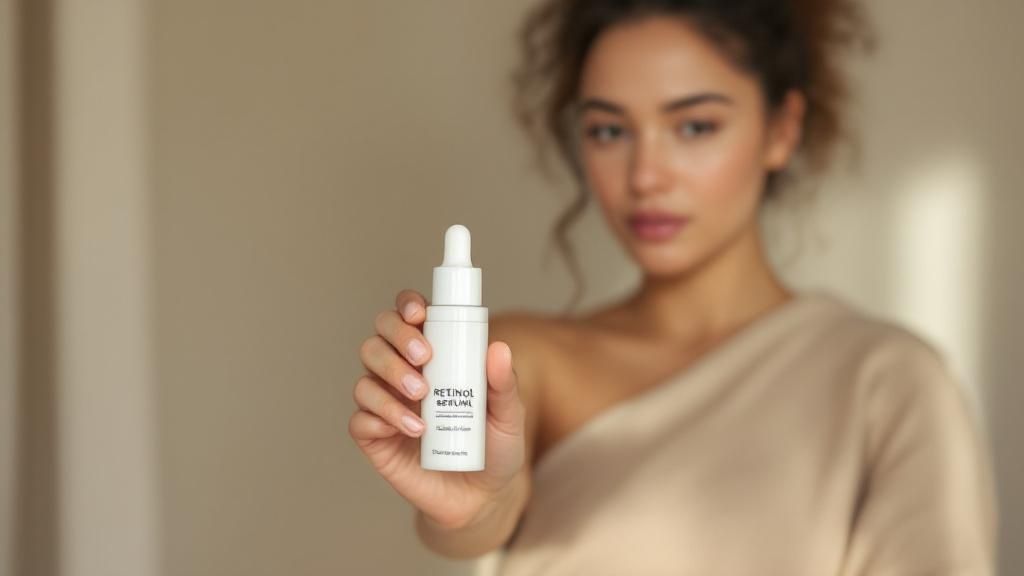
When you’re ready to add a retinol serum to your routine, it’s tempting to grab the strongest formula you can find. After all, stronger means faster results, right? Not exactly. The concentration of retinol in your product is the single biggest factor driving the intensity of potential retinol serum side effects.
Jumping straight to a high-strength formula is one of the most common mistakes I see people make. Think of it like training for a marathon. You wouldn't try to run 26 miles on your first day; you’d start with a mile or two and gradually build your endurance. Retinol works the same way for your skin—you have to build its tolerance over time.
Understanding Retinol Concentrations
Retinol products aren't one-size-fits-all. They come in a range of strengths, and each level is designed for a specific purpose and tolerance level. Knowing the difference helps you make a smarter choice, especially if you're just starting out.
Here’s a quick guide to what you’ll find on the shelf:
- Low Strength (0.01% - 0.03%): This is your starting line. Perfect for beginners or anyone with very sensitive skin, this level lets your skin get used to retinol with a minimal risk of irritation.
- Moderate Strength (0.04% - 0.1%): Once your skin has graduated from the beginner level without any issues, this is your next step up. It's great for tackling uneven skin tone and texture.
- High Strength (0.3% - 1.0%): These potent formulas are for seasoned retinol users only. They deliver more dramatic results for stubborn concerns like deep wrinkles, but they also come with a much higher risk of irritation.
The BARB N.P. Retinol & Bakuchiol Serum was formulated to hit that sweet spot, giving you noticeable results while keeping skin comfort top of mind. By pairing retinol with the soothing properties of bakuchiol, it helps buffer the skin against those overwhelming side effects.
More Strength Can Mean More Irritation
While a higher concentration can work wonders for an experienced user, for most people, it just leads to red, flaky discomfort. Research has confirmed what skincare professionals have known for years: starting low and slow is the most effective way to get results without irritation.
A 2020 clinical study, for example, found that participants using a 0.5% retinol concentration experienced significantly more itching, burning, and peeling than those using a 0.3% concentration. The interesting part? The lower strength still delivered comparable improvements in skin condition.
This really drives home the point that more isn't always better. By starting with a gentler formula, you can reach your skincare goals without the frustrating side effects that cause so many people to give up on retinol altogether. Your skin will thank you for being patient.
A Practical Plan to Minimize Retinol Irritation
Knowing about potential retinol side effects is one thing; having a solid plan to avoid them is something else entirely. Success with retinol isn’t about gritting your teeth through irritation—it’s about introducing it so smartly that your skin barely notices the change.
This isn’t a race. The goal here is to gently build your skin’s tolerance, letting it adapt without getting overwhelmed. A slow, steady approach is what gets you all the radiant benefits without the frustrating downtime.
Start Low and Go Slow
The golden rule of retinol is simple: less is more, especially when you’re just starting out. Your skin needs time to get used to the accelerated cell turnover, and rushing the process is the fastest way to end up with redness and flaking.
Always, always begin with a pea-sized amount for your entire face. Applying more doesn’t speed up results; it just dials up the irritation. For the first few weeks, stick to applying it just one or two nights per week—and never on back-to-back nights.
This visual guide breaks down the essential first steps for a safe and effective retinol journey.
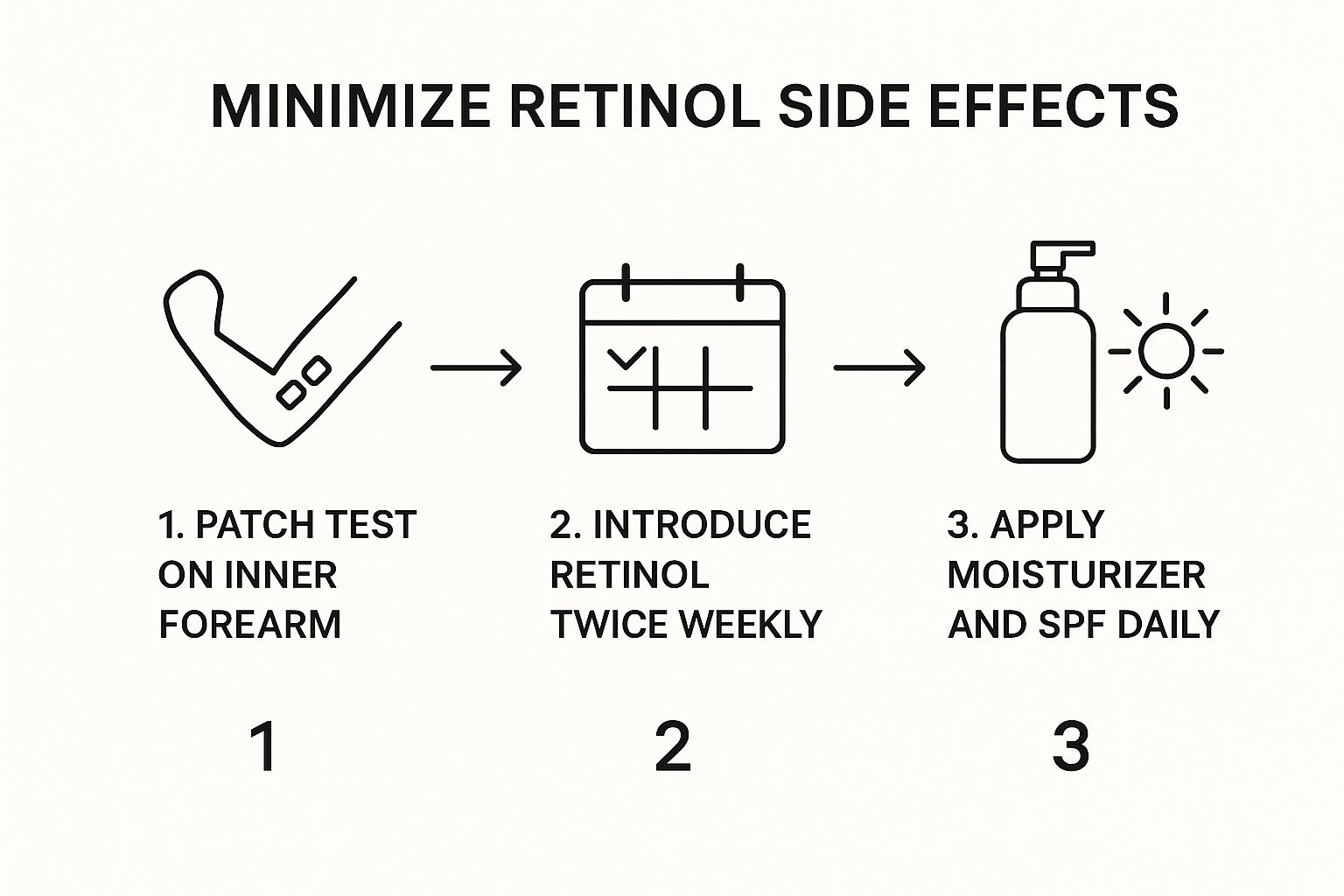
As you can see, a successful routine is built on three pillars: a cautious start, consistent protection, and actually listening to what your skin is telling you.
To make it even simpler, here is a sample schedule you can follow to ease your skin into a new retinol routine.
Sample 4-Week Retinol Introduction Schedule
| Week | Application Frequency | Key Focus |
|---|---|---|
| Week 1 | Once per week | Observation. Watch how your skin responds after the first use. |
| Week 2 | Twice per week (non-consecutive nights) | Building tolerance. Give your skin at least two nights off in between. |
| Week 3 | Every other night (3-4 times per week) | Increasing frequency. If skin is calm, you can move to every other night. |
| Week 4 | Every other night | Consistency. Maintain this schedule, assessing for any dryness or irritation. |
This gradual increase allows your skin's receptors to adapt without becoming overwhelmed, paving the way for consistent, long-term use.
Implement Buffering Techniques
One of the best tricks in the book for minimizing irritation is "buffering." This technique involves creating a protective barrier between the retinol and your skin, which slows down absorption just enough to reduce its initial punch.
The most popular method is the "retinol sandwich," and it’s as easy as it sounds:
- Moisturize First: After cleansing, apply a thin layer of a gentle, hydrating moisturizer to your completely dry skin.
- Add Retinol: Wait a few minutes for the moisturizer to sink in, then apply your pea-sized amount of retinol serum.
- Moisturize Again: Lock it all in with another layer of moisturizer on top.
This sandwich method acts as a cushion, allowing your skin to get the full benefits of retinol in a much gentler, more controlled way. It’s a total game-changer for anyone with sensitive or reactive skin.
Of course, a well-formulated product can do some of the buffering work for you. The BARB N.P. Retinol & Bakuchiol Serum, for example, was designed with this exact principle in mind. It pairs potent retinol with soothing bakuchiol, which helps calm the skin and reduce irritation potential right from the start. This makes the whole adjustment period feel much smoother.
Important Retinol Risks You Should Know
While a little dryness and peeling are expected when you first start retinol, it's smart to be aware of the more serious risks. Think of it like this: retinol is a powerful tool, and you need to know how to handle it safely.
The biggest risk? Photosensitivity. Retinol works by speeding up cell turnover, bringing fresh, delicate new skin cells to the surface. These baby skin cells are incredibly vulnerable to sun damage.
This is why a broad-spectrum sunscreen with SPF 30 or higher isn't just a suggestion—it's completely non-negotiable. If you skip it, you’re not only risking a nasty sunburn, but you're actively undoing all the good work your retinol is doing. In fact, you could end up with more sunspots and premature aging. Sunscreen is your retinol routine’s essential bodyguard.
More Is Not Better
It’s tempting to think that slathering on more retinol will get you faster results. This is one of the biggest mistakes you can make.
Using more than a pea-sized amount or applying it too often will overwhelm your skin, leading to severe irritation, a damaged moisture barrier, and a major setback in your progress.
While it’s extremely rare for topical retinol to cause system-wide problems, we know that Vitamin A can be toxic in very high doses. For context, the recommended daily intake for adults is around 700 to 900 Retinol Activity Equivalents (RAE). You can get a deeper look into the historical context of Vitamin A recommendations on Wikipedia. Respect the ingredient.
Essential Contraindications and When to Stop
There are times in your life when you must avoid retinol completely. The most critical one is pregnancy. High doses of Vitamin A have been linked to birth defects, so medical experts are clear: no retinoids while pregnant, breastfeeding, or trying to conceive.
Always check with your doctor during these life stages.
You should also talk to a dermatologist before starting retinol if you have underlying skin conditions like rosacea or eczema. It can be a game-changer, but it can also be a trigger if not used correctly. Similarly, if you're concerned about issues like sudden facial volume loss, it's a topic for a professional. You can learn more about unexpected side effects like "Ozempic Face" in our detailed guide.
For a powerful-yet-gentle approach, consider a product like the BARB N.P. Retinol & Bakuchiol Serum. It’s formulated to give you results while minimizing the harshness, making it a smarter choice for many people just starting out or those with sensitive skin.
When You Should See a Dermatologist
Knowing how to listen to your skin is probably the most important skill you can develop. While some of the more common retinol serum side effects like a bit of dryness or flaking are totally manageable at home, certain signals are your skin’s way of saying it’s time to call in a professional.
Think of it as the difference between a minor speed bump and a complete roadblock. If that initial irritation just isn’t getting better after a few weeks—or worse, it’s intensifying—your skin is asking for help. A dermatologist can offer personalized advice that a blog post simply can’t.
Red Flags That Require a Professional
This is not the time to "push through it." You need to stop using retinol immediately and book an appointment if you experience any of the following:
- Persistent Burning: A sensation that doesn’t fade away and feels genuinely painful to the touch.
- Blistering or Oozing: These are clear signs of a severe inflammatory reaction and could even point to an infection.
- Significant Swelling: Pay close attention to swelling around the eyes or mouth, which could signal an allergic reaction.
- A Rash-Like Appearance: If your skin breaks out in hives, welts, or a widespread rash that’s intensely itchy.
A dermatologist can properly diagnose what’s going on, telling you if it’s severe irritation versus a true allergic reaction. They have the tools to prescribe treatments that will calm your skin down and get it back to a healthy state—fast.
Ultimately, a professional can also point you toward other treatments or formulations that might be a better fit. For some, a prescription-strength retinoid is the answer, while others might get better results from different procedures altogether. You can learn more about professional treatments like microneedling in our comprehensive guide to see what other options are out there.
Your Retinol Questions, Answered
Diving into the world of retinol can feel a bit intimidating, and it's completely normal to have a few questions pop up. Even once you get the science, you might wonder how it all fits into your specific routine. Let's tackle some of the most common concerns about retinol serum side effects.
How Long Does the Retinol "Purge" Last?
That initial adjustment phase—often called the "retinol purge" or retinization—typically sticks around for two to six weeks. What's happening is that the retinol is kicking your skin's cell turnover into high gear, which can push underlying congestion and micro-comedones to the surface. It might look like a temporary breakout, but it's actually a good sign that the retinol is clearing out your pores.
If you're still dealing with significant irritation or purging after six weeks, it’s probably a good idea to pull back on how often you're applying it. Your skin might just need a little more time to get used to such a powerful active.
Can I Use Vitamin C with Retinol?
Yes, you absolutely can—and you should! But it's all about timing. To avoid potential irritation, it's best to keep them separate. The most popular (and effective) method is applying your Vitamin C serum in the morning for antioxidant protection and your retinol serum at night to handle the repair work. This strategy lets each ingredient shine without overwhelming your skin.
It's also smart to avoid using other strong exfoliants, like AHAs or BHAs, on the same night you apply retinol, at least until your skin is fully adjusted. Layering too many potent actives at once is a classic recipe for a compromised skin barrier.
Is It Normal for My Skin to Burn After Applying Retinol?
A mild, brief tingling sensation can be normal for some people, especially during the first few uses. However, a persistent burning or stinging feeling is a definite red flag. That’s your skin telling you it’s too irritated, and you should wash the product off right away.
This kind of reaction usually means the concentration is too high for your skin, or you simply applied too much product. A great way to head this off is by trying the "retinol sandwich" method: apply a layer of moisturizer, then your retinol, and finish with another layer of moisturizer to create a protective buffer for your skin.
For a formula designed to deliver powerful results with minimal irritation, BARB N.P. recommends the Retinol & Bakuchiol Serum. It pairs potent retinol with soothing bakuchiol, making it an excellent choice for achieving that coveted glow without the uncomfortable side effects. Discover a gentler path to radiant skin.

